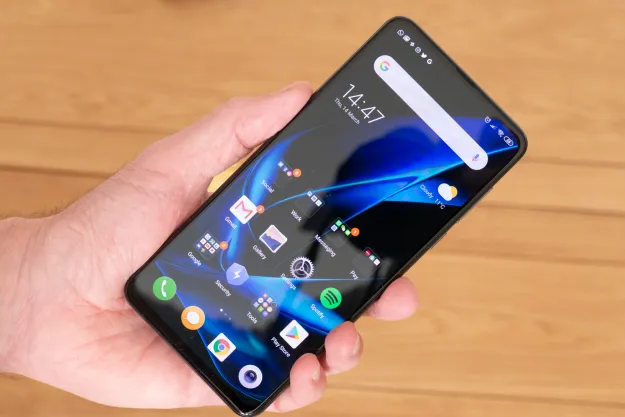
“The Mi Mix 3 is a good phone that’s overshadowed by its own siblings.”
- Slider design is eye-catching
- Plenty of performance
- Camera takes great photos
- Ceramic body is high quality
- No water or dust resistance
- Has been superseded (very quickly)
The Xiaomi Mi Mix 3 is a highly-capable phone that’s all screen with slim bezels around the massive 6.4-inch screen. No notch, no hole-punch, and at first glance, no front-facing selfie camera. What’s its secret? A slider mechanism that reveals the dual-lens front camera when you slide the screen down. It’s a wonderful piece of eye-catching technology that solves the all-screen problem facing most manufacturers today.
Except I’m going to tell you not to buy it, even though it’s excellent, with very few downsides. What’s the problem? The Mi Mix 3 is a stark reminder of how fast the mobile industry moves. It’s barely a few months old, but has already been overshadowed by a subsequent Xiaomi phone release, the announcement of an incoming 5G Xiaomi Mi Mix 3, while also facing serious competition from the rest of the market.
Slider phone
The Mi Mix 3 is the latest in the Xiaomi Mix family, which was the first to introduce the concept of an all-screen phone to the world. The original Mi Mix phone felt incredibly futuristic at the time, while the Mi Mix 3 feels … less so. It’s mainly because we have become more used to smartphones with bezel-less screens, and have already had fun with the slider mechanism on the Honor Magic 2. Don’t take this to mean the Mi Mix 3 is boring though. It’s definitely not.
Without a notch, the Mi Mix 3 has a massive 93.4-percent screen-to-body ratio, and the screen looks stunning. It’s a 6.4-inch AMOLED with a 2,340 x 1,080 resolution. It’s monstrously bright, has an almost faultless contrast level, and vivid colors that keep our eyes glued to the screen. It was easy to use the display tuning mode to get the look just right too. The night mode and reading modes have made it comfortable to use before bed, and video looks great from Netflix and YouTube.
The phone itself is heavy though, at 218 grams, and it’s weighted oddly — likely due to the slider. At 8.4mm, it’s thick by modern standards. Combine this with the slippery body, and you’ll realize just how much you need to hold onto the Mi Mix 3.
The glossy, reflective ceramic rear panel gets smudgy quickly, but it’s so beautiful when it’s clean that I can forgive it. Ceramic is warmer to the touch than glass, provides more scratch protection, and has a wonderful, deep glossy shine that’s irresistible. There is a simple plastic case included in the box. It looks and feels cheap compared to the phone though, but it will offer basic protection.
The Mi Mix 3 is a stark reminder of how fast the mobile industry moves.
Unlike many other high-end phones around at the moment, the Mi Mix 3 has a fingerprint sensor on the back, not in the screen. This is a double-edged sword. One the one hand it’s more reliable and natural to use, but on the other it doesn’t look as modern or high-tech as some of its competitors. The Mi Mix 3 also has face unlock, but to activate this you must slide the slider down to show the camera lenses your face, which can be annoying to do every time you want to unlock the phone.
While we like the all-screen look of the Mi Mix 3, it’s the slider that will split opinion. The mechanism is stiff enough that it doesn’t flop open, and it needs effort to spring. There is a satisfying click from the magnets inside when you do, but the real joy comes from snapping it shut. Xiaomi has engineered the magnetic “ridge” — the point it passes before closing — and the “snap” — where it comes to a stop — perfectly. However, for all the geeky fun, it’s not always easy to open with one hand.

It’s built really well though, doesn’t wobble around, and only introduces a very slight “springiness” when pressing the screen down to slide it open. It does add in an extra step to take selfies, or use face unlock. That said, we like the way it can be customized, either to take a selfie or to open an alternative app, plus there are various sounds to accompany the motion. We like Warrior, which sounds like unsheathing a sword. It’s fun, and there’s often not enough of that in modern phones.
The Mi Mix 3 may not have the same eye-widening, future-shock effect the original Mi Mix did, but it’s infinitely more usable and less fragile, all while boasting a wonderfully-built modern design.
Performance and software
Xiaomi has put a Snapdragon 845 with 6GB of RAM inside the Mi Mix 3, and we have not experienced any performance issues. It plays games well — the viewing experience when playing is also excellent — and the Android 9.0 Pie software with MIUI 10.2 over the top is smooth, fast, and mostly bug-free.
The Mi Mix 3 is a brilliant audio device, especially when you use the Mi Sound Enhancer.
There are some annoyances with the software, especially around notifications which don’t always show on the lock screen, endlessly repeat, or simply show the wrong amount on the icon. We like being able to interact with them through the notifications shade though.
If you’re worried about trying MIUI due to fears over it being very different to other Android experiences, don’t be. It’s one of the cleanest, simplest to adapt to user interfaces available. MIUI 10 is a distinct improvement over previous versions, with a decent gesture control system, minimalist icon designs, Google Assistant, and a slick design. It’s not confusing either, once you get used to the layout of the Settings menu, which differs from other Android devices. Google Assistant is really quick to respond to voice commands, and we’ve found it often wakes more quickly than other devices or even the Google Home.
Benchmark tests show how the Mi Mix 3 compares to other smartphones:
- AnTuTu 3DBench: 297,251
- Geekbench 4 CPU: 2,412 single-core; 8,922 multi-core
- 3DMark Sling Shot Extreme: 3,708 (Vulkan)
These are strong scores, often equaling or beating the OnePlus 6T McLaren Edition, and the Samsung Galaxy S9 and Note 9. You won’t have any complaints with the speed or performance of the Mi Mix 3, but it can’t match the Galaxy S10’s astonishing figures. Just remember that it’s using the Snapdragon 845, a chip that has been superseded by the Snapdragon 855, if owning the very best available right now matters to you.
Camera
There are four camera lenses on the Mi Mix 3 — a 24-megapixel, f/1.8 aperture main lens and a 2-megapixel depth lens on the front under the slider. On the back is a dual-lens 12-megapixel setup, with the main lens again having an f/1.8 aperture plus optical image stabilization, autofocus, HDR, various artificial intelligence modes, a 2x zoom, and a Night mode. The selfie camera takes portrait-style bokeh shots — both stills and video — and has an extensive artificial intelligence-driven beauty mode.
Xiaomi has taken the rear camera from the Mi 8 for use on the Mi Mix 3, but the experience has been better on the Mi Mix 3, which we put down to more mature software and some tweaks over the last months. Daytime photos on sunny days look superb, with bright colors popping off the screen, sharp detail, and sensible contrast levels. They are not overly saturated, although don’t quite have the natural look you’d get from the iPhone XS.
- 1. Night mode
- 2. Standard mode
Night mode isn’t useful during the day, unlike Huawei’s version, but does enhance low-light shots in darkness. In street photos using Night mode, street lights are less blown out, there’s more detail than without it, and colors are better realized. However, some shots have a strange halo-effect where light areas meet darkness. It’s distracting, and makes the photos look less realistic.
Bokeh mode on the rear camera is decent, but can fail to recognize some objects. It’s better at recognizing human shapes though. For selfies, the Mi Mix 3’s portrait mode is better, and edge detection impresses. Side-on shots usually fail to understand the edge of my glasses shouldn’t be blurred out, but the Mi Mix 3 captures them more effectively. The beauty mode is as subtle or as aggressive as you like, and there are plenty of adjustments to be made if you want them. There’s also a bokeh mode for video using the front camera, but it’s only moderately successful, with the edge detection not being accurate enough to make the video look its best.
The camera app has a comprehensive editing suite with image adjustments, cropping, filters, and some more unusual tools like an eraser. There is a similar editor for video as well, with filters, a trim tool, and some artificially intelligent-driven effects too. This is worth noting, as many other camera apps ignore video editing tools. It’s all very easy to use, with sensibly-placed buttons to toggle the features, and a simple scrolling menu system to change modes. The Mi Mix 3’s camera is excellent, creatively fun, and simple to use.
Battery, charging, and audio
Don’t be disappointed by the Mi Mix 3’s 3,200mAh battery, even if on paper it’s smaller than many of its peers. It’s a strong performer, returning easily a day’s worth of heavy use. It won’t stretch into a full second day, but with moderate use it’d likely make 24 total hours. A YouTube video ran for 10 hours and 45 minutes on a full charge, at 1080p and maximum brightness. That’s around the same time as the Samsung Galaxy S10 in the same test.
We like the Mi Mix 3 a lot, but it’s worth waiting for the alternatives.
It’s charged using a USB Type-C cable with Quick Charge 4.0, or a 10-watt wireless charger, which is included in the box. The cable charge is fast, and using the included charger, the battery was full in an hour and 20 minutes.
There’s no 3.5mm headphone jack on the Mi Mix 3, so you either need Bluetooth headphones or a dongle. Listening to Spotify using a dongle and a pair of OnePlus Bullets revealed the Mi Mix 3 to be a brilliant audio device, especially when you use the Mi Sound Enhancer setting. This has different equalizer settings for various Mi headphones, but the General mode is suitable for all, and makes a genuine difference — from a wider soundstage to enhanced bass and stronger vocals.
The phone has plenty of volume too, though the external speaker is disappointing. Apart from easily being blocked just by holding the phone, it doesn’t have much finesse.
Price, warranty, and availability
This is a Xiaomi phone which means it’s not available to buy in the U.S., although you can purchase an import model if you’re really keen. It’s sold officially in the U.K. through Xiaomi’s online store and its retail partners sell it for 500 British pounds, which works out to around $660. The Mi Mix 3 has a two year warranty in the U.K., and is available to buy now.
Our Take
The Mi Mix 3 is an excellent smartphone, with a striking design, a good camera, and plenty of power. Except you shouldn’t buy it. The reason isn’t to do with the phone, which has very few downsides, but everything to do with the other phones you can buy now or in the very near future.
Are there any alternatives?
Here’s where I explain why you shouldn’t buy the Mi Mix 3. Right away, if you’re set on a high-end Xiaomi phone, we recommend you by the new Mi 9 instead. It has a 500 euro price, which means it will likely cost a little less in the U.K. and therefore less than the Mi Mix 3, it has the new Snapdragon 855 processor, and a triple-lens camera too. It’s a better purchase than the Mi Mix 3 at the moment, when you consider longevity.
On that same subject, the other thing to remember is the 5G Mi Mix 3 will be released in May. It will come with a Snapdragon 855 processor and 10GB of RAM, and cost 600 euros or about $680. If you’re really taken with the design and slide-up camera on the Mi Mix 3, it is worth waiting for the updated version for real future-proofing. Xiaomi is to blame for making the desirable Mi Mix 3 less desirable in a very short space of time.
It has serious competition from other brands too. The Honor View 20 looks fantastic, has a brilliant camera, plenty of power, and costs around 500 pounds/$660. The OnePlus 6T may be getting old (by OnePlus’ standards) but it’s still a strong purchase at $550, plus the OnePlus 7 will be here before we know it too. The Samsung Galaxy A9 (2018) costs 550 pounds, and the new Nokia 9 PureView is 600 pounds, or $700. You could buy any of these and not look back.
How long will it last?
The ceramic body will resist scratches, but not harsh drops, and the all-screen front won’t enjoy any sharp impacts either. However, the slider mechanism should be good for 300,000 open and close cycles according to Xiaomi, and in JerryRigEverything’s durability test, it performed well with the minimum of flex. We certainly haven’t had any concerns. It feels rock solid, and never once feared it breaking during our time with the phone. You won’t want to get the Mi Mix 3 near water or too much dust though. It does not have an IP rating due to the slider mechanism.
This is a flagship phone, and the modern design will keep it looking fresh for some time, but the processor has since been updated by Qualcomm, and there will be a lot of more powerful phones out over the coming months. It’s not going to be considered out of date for several years though, so buy with confidence, if you can’t resist.
Should you buy one?
No. Ridiculously, there’s absolutely nothing wrong with the Xiaomi Mi Mix 3. The problem is the Mi 9 is technically more capable, and will therefore be a better long-term purchase. Additionally, the looming 5G version is only a few months away, and will relegate the standard Mi Mix 3 to the sidelines in terms of longevity once again. We like the Mi Mix 3 a lot, but it’s worth waiting for the alternatives at the moment.
Editors' Recommendations
- Qualcomm is about to make cheap Android phones better than ever
- Wear OS 3 is finally coming to these older smartwatches this month
- New Xiaomi phones are launching on July 4 with (hopefully) amazing cameras
- TicWatch Pro 3 Ultra hands-on review: Amazing battery life
- The best Samsung Galaxy Z Fold 3 screen protectors

























